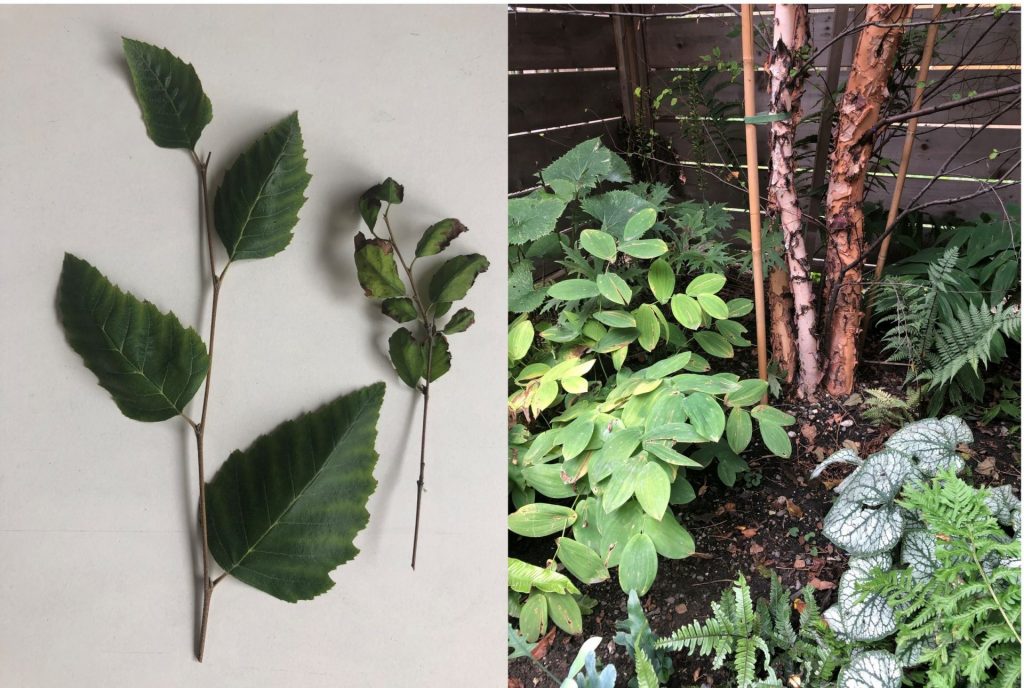
Hello,
I planted a river birch – Betula Nigra – in May 2018 – three stems forming a clump. it is planted in a small urban garden with mixed sun and shade – approximate height – 20ft – spread – 9ft) On one of the three stems, the leaves are small and exhibit brown edges and are curled at the edges. The other two stems do not show any similar symptoms. The two normal stems seem to be growing normally – the bark has a more pronounced brown colour – like the bark of similar clumps I have seen. The third stem (with the curled leaves) is significantly smaller in diameter and the bark colour is much lighter. The third stem has not developed as well as the other two. This condition appeared in the first year. I expected that if it was a blight of some sort, it would spread to the other two stems but so far they do not exhibit the same symptoms. Photos of the clump showing the bark condition (the pale bark is the affected stem (the third stem is in the back of the photo) and sample leaves from the tree is attached. Your advice will be greatly appreciated.
Brian
Thank you for contacting the Toronto Master Gardeners concerning your River Birch Tree.
River Birch is a medium to fast growing tree that grows best in full sun -part shade, with at least a minimum of 4 hours of direct sunlight. This tree is not particular when it comes to soil. It will grow in moist, acidic, loamy, sandy, well-drained and clay soils. River birch has no serious pests, however it is susceptible to fungal leaf spot which leads to premature leaf drop, see Clemson Cooperative Extension on River Birch.
From your photo it does not appear as if your tree is suffering from fungal leaf spot. I am wondering if your problem is from improper planting. Was your tree planted at the proper depth? Did you add any inorganic or organic amendments to the planting hole? Did you check the root ball for girdling roots?
The importance of planting a tree at the correct depth cannot be overemphasized. Planting too deeply will eventually lead to the death of the tree. The place where the roots meet the trunk is called the trunk flare or the root collar. Unlike roots, trunks are not meant to be buried in soil and if this happens, they may rot, become diseased or die. The tree must be placed in the ground so that the soil grade is level with the bottom of the root collar. When planted at the proper level you will see the gentle flare of the trunk rise just above the soil line. Err on the side of placing the tree higher above the soil, especially if you suspect the soil will settle or the site is not well drained. It is easier to add soil after planting, than to replant a tree with a sunken trunk flare.
Early thinking was to amend the soil before planting, by digging in either inorganic material, such as sand and gravel to ‘loosen a heavy soil’ and ‘improve drainage’ or organic material, such as compost, leaf mold or manure to ‘get your plants off to a good start’. Current thinking does not support either of these approaches. By adding inorganic materials, such as sand or gravel, you create barriers to the un-amended soil, reduce the ability of air and water to move through the soil. This can result in a perched water table.
Originally it was thought by adding new top soil, manure or compost to enhance the soil, was a good way to nurture the roots, but in fact, you are creating a soil pocket which is unlike the surrounding soil. The roots may initially grow well, but as they come to the edge of the soil in the planting pocket, they will resist growing into the surrounding soil. Any amendments should be added to the top of the soil when planting is completed.
If the tree has been wrapped in burlap too long, the tips of the roots may have grown to the edge of the wrapping, been exposed to air and heat and died. If a tree has been in a container too long, the roots may hit the pot edge and begin to grow in a circle, becoming matted and tangled. Circling roots will become girdling roots and the plant will die from lack of air, water and nutrients.
My suggestion would be to call in a certified arborist to look at your tree. To find a certified professional arborist to help you with a tree problem, visit the International Society of Arboriculture’s searchable database here.
Good Luck with your River Birch
September 13, 2021

